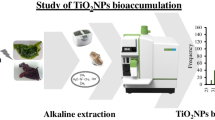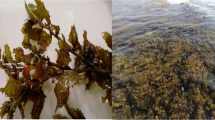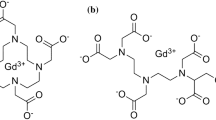Abstract
The green algae Chlorella (Chlorella pyrenoidosa) have the ability to bind high amounts of uranium(VI) in the pH range from 3 to 6. At pH 3 up to 20 % of the uranium is bound by the algal cells whereas the uranium removal by algal cell is almost complete at pH 5 and 6 in the concentration range of 4 × 10−4 to 1.6 × 10−3 M. Sorption capacities are in the range of 300–350 mg g−1 and 250–280 mg g−1 for fresh water and seawater respectively. Concentration of uranium was measured by inductively coupled plasma optical emission spectroscopy (ICP-OES) by using two different emission spectral lines at 409.014 and 424.167 nm. Environmental scanning electron microscopy (ESEM) complimented with energy dispersive X-ray (EDX) is used to characterize the binding sites of uranyl species on algal cell in the selected pH range. The micrographs show a regular distribution of U(VI) on the cell surface. Attenuated total reflectance-fourier transform infrared (ATRFTIR) spectrum of Chlorella indicates that the binding of U(VI) either to phosphodiesters (P–O–aryl/P–O–alkyl), and combination of amine, secondary amine and imine = NH respectively. These sites in Chlorella groups are mainly responsible for the removal and binding of U(VI) by formation of organic and/or inorganic uranyl phosphates.
Similar content being viewed by others
Explore related subjects
Discover the latest articles, news and stories from top researchers in related subjects.Avoid common mistakes on your manuscript.
Introduction
Uranium, is one of the important metals due to its demand in nuclear industries for power generation. Therefore efforts are being made to recover it back from various waste streams originated during various stages of nuclear fuel cycles as well as from various sources like sea water, leachants of rock phosphate and others. In terms of natural abundance in nature, it is well known, for instance, that seawater contain 1–5 ng mL−1 of uranium whereas surface and groundwater depending upon the geo-chemical environment concentration of uranium from <μg L−1 to 600–700 μg L−1. Uranium is one of the important naturally occurring radionuclides and having a concentration of around 3.2 μg g−1 in the soil except in the areas rich with uranium ore. Igneous rocks of granitic composition are strongly enriched in U with an average 5 μg g−1 compared to rocks of basaltic composition having an average concentration <1 μg g−1 [1].
Chlorella pyrenoidosa (C. pyrenoidosa) is a unicellular green alga that grows in fresh water. It has the highest content of chlorophyll of any known plant. Chlorella growth factor (CGF) is a water-soluble extract and contains a variety of substances including amino acids, peptides, proteins, vitamins, sugars, and nucleic acids. Estimates of the CGF content in raw C. pyrenoidosa is approximately 5 % [2]. Presence of chemical active sites in the biomass that are responsible for sequestering metals from the surrounding solution make them very good bio-sorbent material [3, 4]. This accumulations is dependent on the concentration of the biomass, the pH value, the temperature and the cultivation time. Some studies about the sorption behaviour of the unicellular microalgae Chlorella regarding uranium(VI) have been published. Horikoshi et al. [5] reported that the uptake of uranium by Chlorella regularis is very rapid and is not affected by light, temperature, or treatment with metabolic inhibitors. The results indicate that the uptake of uranium by Chlorella is only dependent on the physical adsorption on the cell surface. Electrostatic attraction and chemical sorption of uranyl ions through complex formation with cellular ligands thus play a role in this process.
During this work laboratory simulated experiments were conducted to concentrate the uranium from water samples from fresh water and sea water. The term bio-sorption is used to describe the metabolism-independent sorption of heavy metals and radionuclides to biomass. The biosorption largely depends upon the chemical speciation of the metal ion in solution and physicochemical characteristics of biomass (algal cell).
Materials and methods
Preparation of experimental solutions
Simulated groundwater and seawater samples were prepared by contaminating them with U(VI) solution after adjusting the pH with 4 M HNO3 or NaOH. Physicochemical characteristics of the samples were measured before and after the contamination of the solution. Contamination was carried out by using stock solution of UO2(NO3)2 having a stock solution of strength 10 g L−1 prior to contamination solution was filtered through 0.45 μm filter paper.
Chlorella pyrenoidosa
Chlorella pyrenoidosa was grown in a liquid algal full medium under air supply and light until the end of the exponential growth phase [2, 6]. The algal biomass was harvested by centrifugation and washed with [weight per volume (w/v)] deionized water. The physical and chemical characterization of biomass was done by using elemental analyzer, ATR-FTIR and SEM-EDX.
Cell dry weight
The cell suspension were filtered through pre-washed and pre-weighed membrane filters (0.45 μm). The filters were dried in an air oven at 80 °C for 24 h. Algal biomass was determined before and after the experiments.
Uranium uptake by algal biomass, experimental conditions
The concentration of algal biomass (dry mass) is varied between 0.1 and 0.8 g L−1 whereas uranium concentration varied in the range of 2 × 10−5 to 4 × 10−4 M. For the sorption experiments the algal biomass was contacted 72 or 144 h with U(VI) solutions at pH 3, 5 and 6. The pH values of the solutions were adjusted with 4 M HNO3 or NaOH. The uranium concentration in each solution was checked by ICP-OES (activa) after separation of the algal biomass. The amount of sorbed U(VI) in the biomass was calculated by formation of the difference between initial and final concentration of uranium in the solution. In addition, equal samples without biomass were investigated.
Measurement of uranium by ICP-OES
Determination of uranium was carried out by using simultaneous solid state detector inductively coupled plasma optical emission spectrometer (ICP-OES, model ACTIVA, from Horiba Jobin–Yvon SAS, France). Intensity of emission was measured at two different wavelength i.e. 409.014 and 424.167 nm. The calibration of instrument was carried by using Aldrich standard solution of uranyl nitrate. ACTIVA utilizes a 2048 × 512 pixel, ultra-low noise, high quantum efficiency charge coupled device (CCD) solid-state detector. ACTIVA includes a unique optical design featuring a 0.64 m Czerny-Turner optical system and holographic gratings of 4,343 grooves per mm and 2,400 grooves per mm covering the full 6 mm height of the plasma. “Normal analytical zone multi-WAV” acquisition mode provides complete sample fingerprinting of 75 elements in <30 s. It gives resolution up to 10 pm. Concentration of uranium in different samples was also validated by using other techniques [7, 8].
Measurement of mean hydrodynamic diameter of particle distribution of algal suspension and zeta potential
Size distribution and zeta potential of the suspension of algal biomass was studied at different pH using Malvern Zetasizer Nano ZS. Measurements were carried out by dynamic light scattering using He–Ne laser with a power of 4.0 mW and wavelength 633 nm. The intensity of the scattered light was measured using an avalanche photodiode detector at room temperature (25 °C) having a quantum efficiency >50 % at 633 nm.
ESEM (environmental scanning electron microscope)–EDS (energy dispersive spectrometry)
The surface morphology of algal biomass collected on filter paper having pore size ≤0.45 μm was studied using scanning electron microscopy (SEM) coupled with energy dispersive X-ray fluorescence spectrometry (EDS) (instrument model no VEGA MV 2300T). Dehydrated samples of algal biomass were fixed with sticky conductive carbon tapes on the sample holder.
Results and discussion
Table 1 gives the various physicochemical characteristics of the four different solutions used for conducting various experiments. From this table its clear that’s there is not much variation in the concentration of various ions in groundwaters (sample 1–3). These observation clearly indicates that sample collected are from similar geochemical environment whereas sample 4 is a sea water sample and the concentration of various measured ions are in close agreement with the literature value for sea water composition.
Characterization of Chlorella pyrenoidosa
Chemical composition
Table 1 gives the composition of isolated algal biomass. The content of protein, carbohydrate, lipid and nucleic acid are in close agreement with the earlier works as shown in Table 2.
Hydrodynamic diameter of algal suspension
Size distribution of algal suspension obtained by maintaining the pH in the range of 3–6 Fig. 1 shows the typical size distribution as obtained at pH 5. From this figure it is clear that suspension of C. pyrenoidosa was dominated by particles having hydrodynamic diameter of 4.8 μm whereas in other experimental conditions the similar distribution was obtained. However the zeta potential value was −50, −52, −58 and −60 mV at pH 3, 4, 5 and 6 respectively. Distribution of zeta potential value at pH 5 is shown in the Fig. 2. All these values of zeta potential indicating higher stability of colloidal suspension in different experiments. The surface charge on C. pyrenoidosa originates chiefly from ionization of various surface active site on the algal biomass. Surface charge among this group is strongly dependent upon pH, being positive at lower pH and negative at higher pH.
Sorption of uranium by algal suspension
Figure 3 give the variation of uptake of uranium with algal biomass (C. pyrenoidosa) in the concentration range of 0.1–0.8 g at pH 3, 5 and 6 and contact time varies between 1 and 72 h. At pH 3 and a contact time of 1–72 h low uranium amounts (7–9 %) of initial concentration of uranium were taken up by algal cell (Fig. 3). In contrast to that, 94 % of the uranium in the initial solutions was immobilized by algal cells at pH 6. Furthermore, an increase of the binding capacity with longer contact time and higher pH value was experimentally observed. The increasing deprotonation of the functional groups of the algal cells, in particular carboxyl and phosphate groups, with increasing pH value could be the reason for this. A higher binding rate for uranium was observed during the sorption experiments with a biomass concentration of 0.8 g algae dry weight L−1; 4 × 10−4 M uranium and the same contact time of 72 h in comparison to the corresponding experiment with a lower algal concentration. Experiment conducted at different concentration of uranium shows that uranium is not sorbed linearly with increasing uranium concentration, ranging from 2 × 10−5 to 4 × 10−4 M. The corresponding percentage uranium removal from the solution by algal biomass decreases with increasing initial uranium concentration in the range from 8 to 4.9 % at pH 3. At pH 5 and 6 the uranium sorption decreases from 92 and 94 % to 30 and 56 %, respectively. This fact points the presence of a limited number of binding places in the algal biomass [9–11]. The change of uranyl speciation in the designated uranyl concentration range at pH 5 is negligible in this process.
Mechanism of uptake of uranium
The term bio-sorption is used to describe the metabolism-independent sorption of heavy metals and radionuclides to biomass. It encompasses both adsorption (the accumulation of substances at a surface or interface) and absorption (the almost uniform penetration of atoms or molecules of one phase forming a solution with a second phase. Both living and dead biomasses are capable of biosorption and ligands involved in metal binding. The green algal matrix consist of complex hetro-polysaccharides. Bio-sorption in algae has been attributed mainly to the cell wall, where both electrostatic attraction and complexation can play a role. Bio-accumulation of lanthanum, uranium and thorium has been investigated by Young and Macaskie [12, 13] had suggested that the uptake of these metal ions by bio-mass is mostly depends upon physio-chemical adsorption at the cell surface and not on its biological activity. The Fig. 4 give the ATR-FTIR spectrum of C. pyrenoidosa loaded with uranium. The spectrum is recorded between wavenumbers 400–4,000 cm−1. The peak at 1081, 1384 and 3,423 cm−1 suggest the presence of thioether, phosphodiesters (P–O–aryl/P–O–alkyl), and combination of amine, secondary amine and imine = NH respectively in Chorella [9]. As these bands show slight shift from their expected values indicates, probable binding of uranium (UO2 2+) with these functional group causing more stress on vibrational bands.
The biosorption largely depends upon the chemical speciation of the metal ion in solution. Information on the active sites involved in the sequestration of sorbates (uranium) can also be studied by using sophisticated instrumental analyses such as environmental scanning electron microscope hyphenated with energy dispersive X-ray (ESEM–EDX). Figure 5 shows the micrograph of C. pyrenoidosa loaded with uranium and from this figure its clear that there is uniform distribution of uranium in algal matrix. This is validated by recording EDX spectrum at different locations and similar concentration of uranium was observed at various points. Typical spectrum obtained is shown in Fig. 6.
In order to understand the various species of uranium present at pH 3, 5 and 6, work carried out by Wolery [14] using computer program EQ3/6 was used. As per this uranium speciation model at 4 × 10−4 M initial uranium solutions showed that the uncomplexed uranyl ion UO2 2+ dominates the U(VI) speciation at pH 3. At pH 5, uranium forms in addition to the free uranyl cation (18.9 %) different hydroxides like (UO2)3(OH) +5 (45.8 %), (UO2)2(OH) 2+2 (15.8 %), UO2OH+ (11.3 %),(UO2)4(OH)7+ (5.3 %) and (UO2)3(OH)4 2+ (2.2 %). At pH 6, the uranyl species (UO2)3(OH)5+(65.4 %), (UO2)4(OH) +7 (18.5 %), UO2OH+ (2.7 %) and (UO2)2CO3(OH)3 − (10.6 %) are the main species in this initial solution. In the broader concentration range of 2 × 10−5 to 4 × 10−4 M at pH 3 and 6 the uranium speciation in solution is similar to the calculated speciation of the corresponding 4 × 10−4 M uranium solutions. At pH 5 and a uranyl concentration 2 × 10−5 M the speciation changes in favour of the free uranyl cation (up to 49 %) and UO2OH+ (up to 30 %) [15–17].
Evaluation of sorption capacity of Chlorella pyrenoidosa
The quality of the sorbent material is judged according to how much sorbate it can attract and retain in an ‘‘immobilized’’ form. In the present work, sorption capacity of C. pyrenoidosa was evaluated for two different conditions i.e. groundwater and seawater. The calculation of the uranium uptake [mg g−1 (dry) sorbent] is based on the material balance of the sorption system. Sorption capacities are in the range 300–350 mg g−1 for fresh water and 250–280 mg g−1 seawater. Lower sorption capacity in the case of sea water is attributed to the presence Cu, Cd, Ni and Zn in sea water and as per the work done by Fraile et al. [17, 18] have observed that, Chlorella have tendency to bind these metal ions at the corresponding pH value.
Conclusion
Sorption specificity of Chlorella pyrendoidosa for uranium can be utilize for the recovery of uranium from various aquatic waste stream originated from the mining and milling of uranium as well as same can be used to recover very low level of uranium from sea water.
References
Singhal RK, Sharma PK, Bassan MKT, Basu H, Reddy AVR (2011) Comparative determination of uranium in rock phosphates and columbite by ICP-OES, alpha & gamma spectrometry. J Radioanal Nucl Chem 288:149–156
Myers J (1944) The growth of Chlorella pyrenoidosa under various culture conditions. Plant Physiol 19:579–589
Donat R, Esen K, Cetisli H, Aytas S (2009) Adsorption of uranium(VI) onto ulva sp.-sepiolite composite. J Radioanal Nucl Chem 279:253–261
Crist RH, Martin JR, Eslinger JM, Crist DR (1990) Interaction of metals and protons with algae 2. Ion exchange in adsorption and metal displacement by protons. Environ Sci Technol 24:337–342
Horikoshi T, Nakajima A, Sakaguchi T (1979) Uptake of uranium by Chlorella regularis. Agric Biol Chem 43(3):617–623
Khoshmanshi A, Lawson F, Prince FG (1996) Cadmium uptake by unicellular green microalgae. Chem Eng J 62:81–88
Singha lRK, Preetha J, Karpe R, Hema P, Kumar A, Joshi VM, Ranade AK, Hegde AG (2009) Improvement in the determination of traces of uranium in aqueous medium having high dissolved organic carbon and chloride ion by alpha-spectrometry. J Radioanal Nucl Chem 279(1):301–306
Singhal RK, Basu H, Bassan MKT, Manisha V, Avhad DK, Sharma PK, Reddy AVR (2012) Rapid and interference free determination of ultra trace level of uranium in potable water originated from different geochemical environment by ICP-OES. J Radioanal Nucl Chem 292:675–681
Singhal RK, Joshi S, Tirumalesh K, Gurg RP (2004) Reduction of uranium concentration in well water by Chlorella (Chlorella pyrendoidosa) a fresh water algae immobilised in calcium alginate. J Radioanal Nucl Chem 261(1):73–78
Gin KYH, Tang YZ, Aziz MA (2002) Derivation and application of a new model for heavy metal biosorption by algae. Water Res 36(5):1313–1323
Al-Rub FAA, El-Naas MH, Ashour I, Al-Marzouqi M (2006) Biosorption of copper on Chlorella vulgaris from single, binary and ternary metal aqueous solutions. Process Biochem 41(2):457–464
Yong P, Macaskie LE (1988) Bioaccumulation of lanthanum, uranium and thorium, and use of a model system to develop a method for the biologically-mediated removal of plutonium from solution. J Chem Technol Biotechnol 71:15
Donat R, Cılgi GK, Aytas S, Cetisli H (2009) Thermodynamics parameters and sorption of U(VI) on ACSD. J Radioanal Nucl Chem 279:271–280
Wolery TJ (1992) Report UCRLMA-110662 part 1. Lawrence Livermore National Laboratory, California
Meinrath G (1997) Uranium(VI) speciation by spectroscopy. J Radioanal Nucl Chem 224:119–126
Meinrath G (1996) Coordination of uranyl(VI) carbonate species in aqueous solutions. J Radioanal Nucl Chem 211:349–362
Fraile A, Penche S, Gonzalez F, Blazquez ML, Munoz JA, Ballester A (2005) Biosorption of copper, zinc, cadmium and nickel by Chlorella vulgaris. Chem Ecol 21(1):61–75
Becker EW (1994) In: Baddiley (ed) Microalgae: biotechnology and microbiology. Cambridge University Press, Cambridge, New York, pp 186–187
Author information
Authors and Affiliations
Corresponding author
Rights and permissions
About this article
Cite this article
Singhal, R.K., Basu, H., Pimple, M.V. et al. Spectroscopic determination of U(VI) species sorbed by the Chlorella (Chlorella pyrenoidosa) fresh water algae. J Radioanal Nucl Chem 298, 587–592 (2013). https://doi.org/10.1007/s10967-013-2455-5
Received:
Published:
Issue Date:
DOI: https://doi.org/10.1007/s10967-013-2455-5










